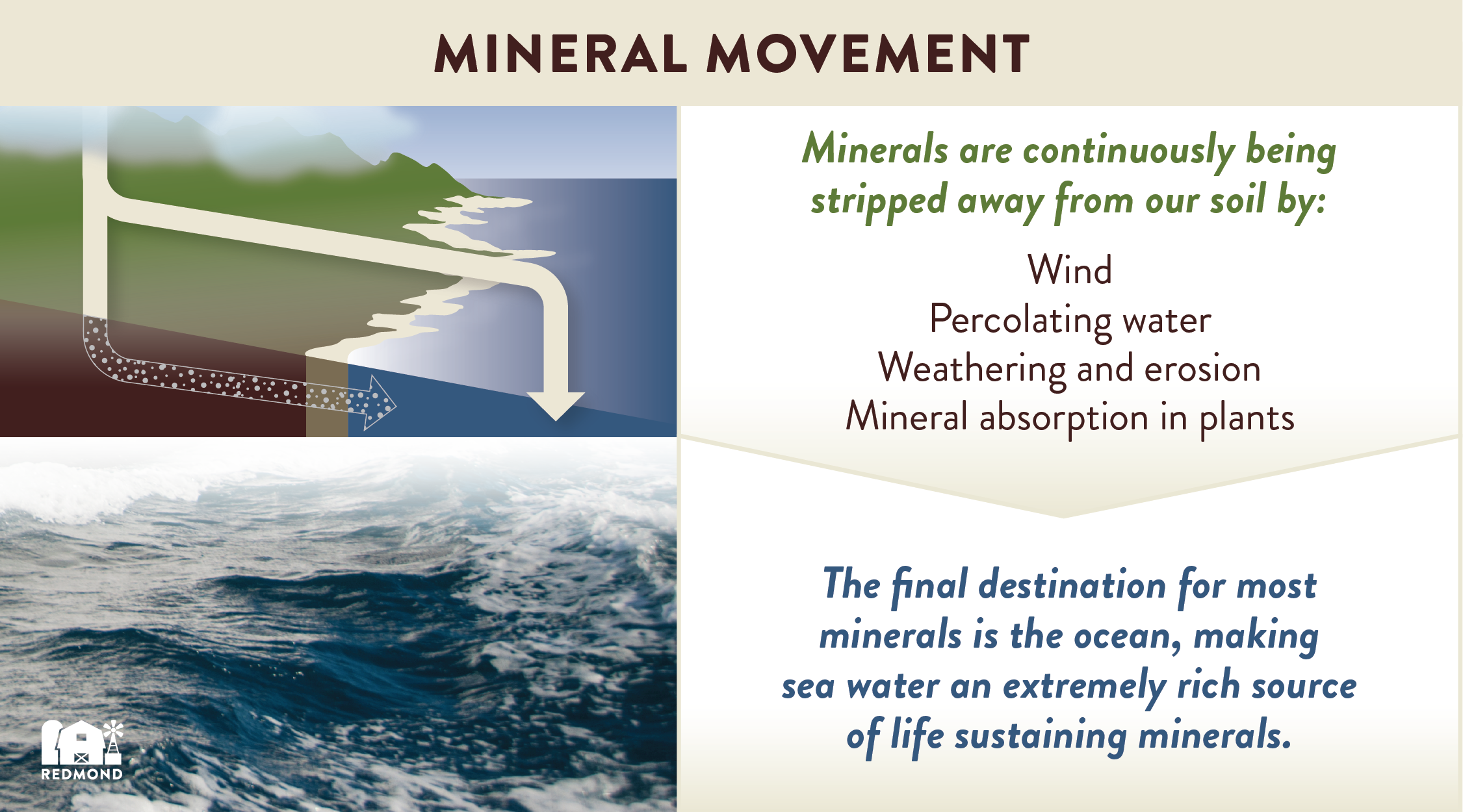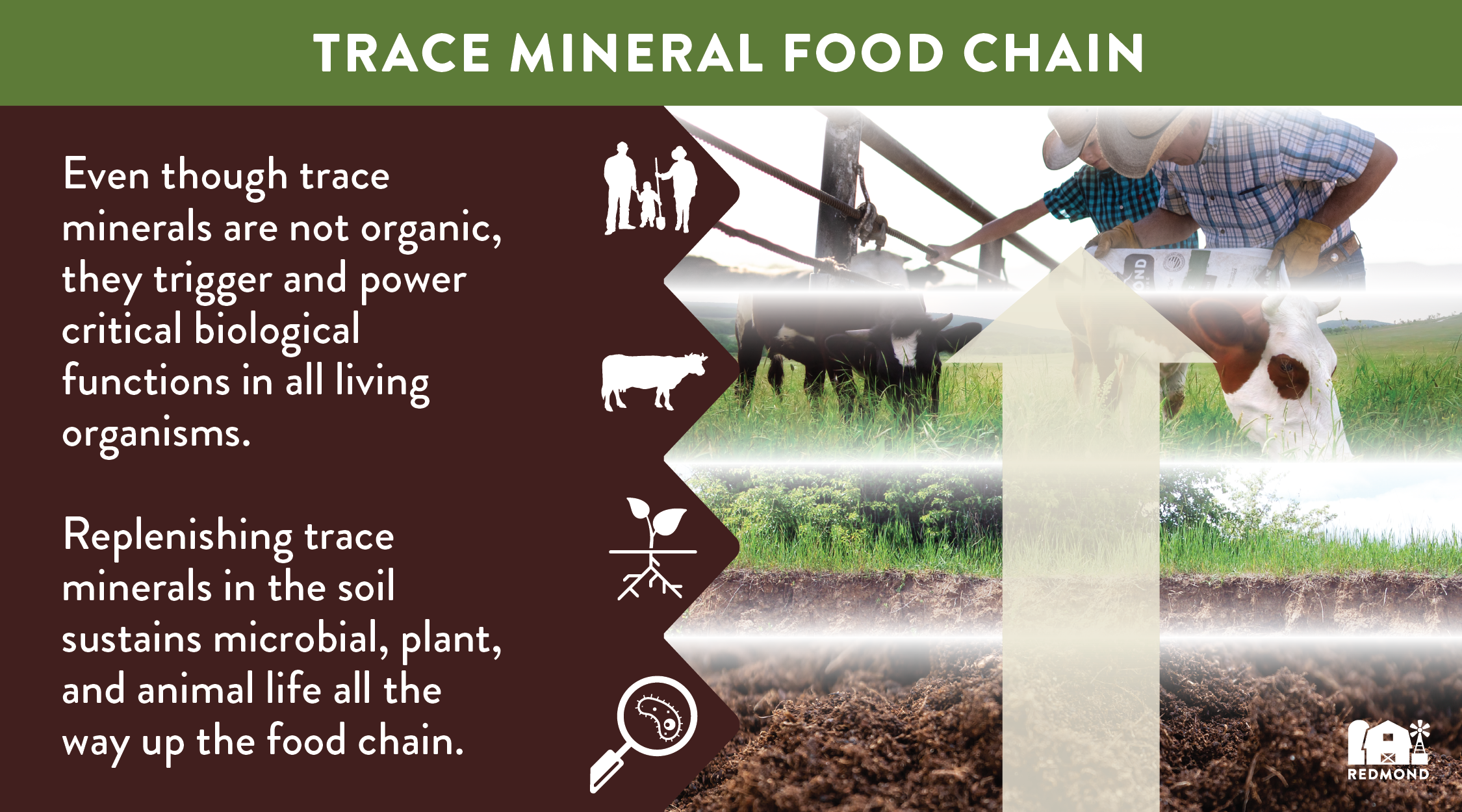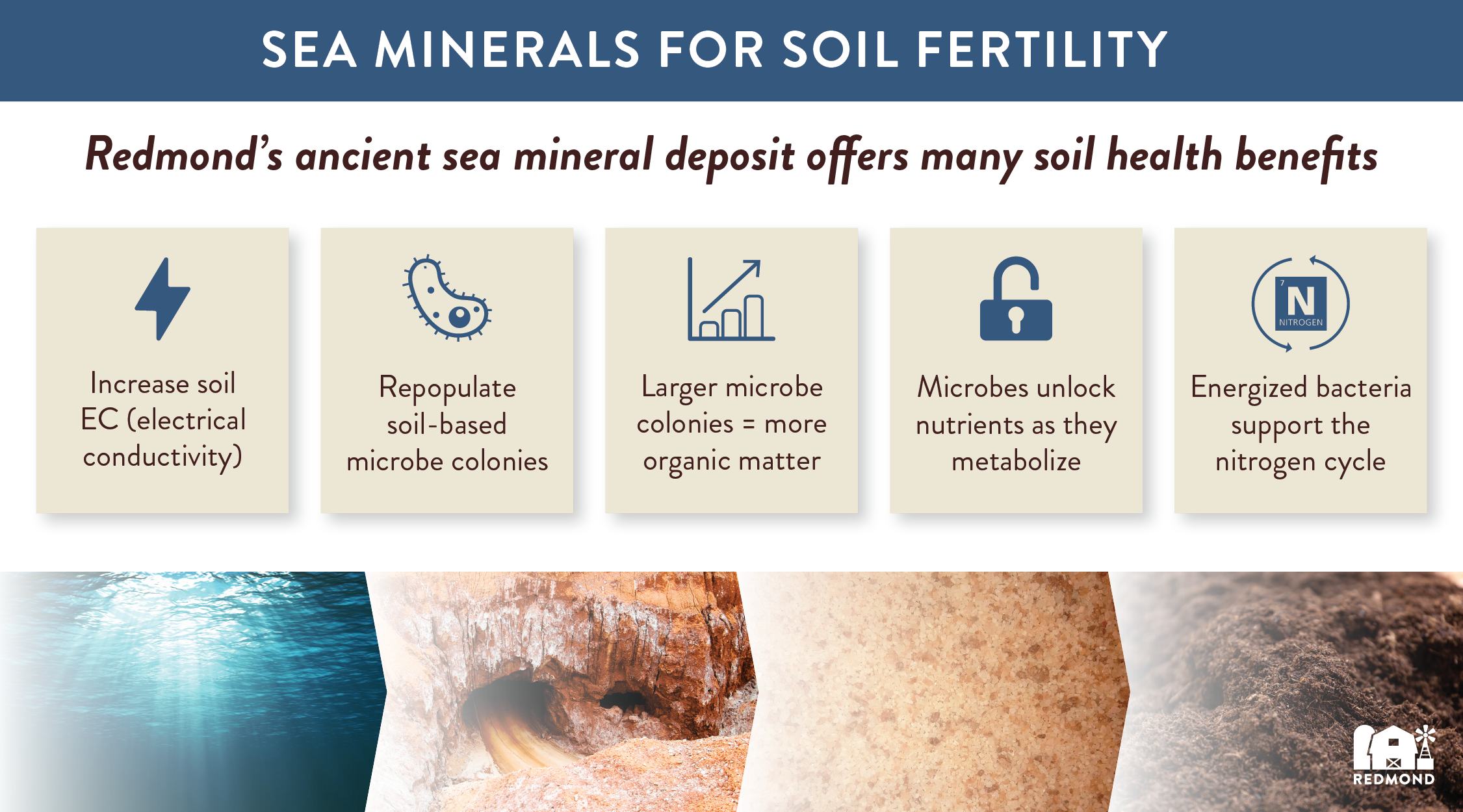The Mineral Cycle
The mineral cycle is a bio-geo-chemical process that is constantly happening all around and inside us as minerals move through soil, organisms, air, and water. This cycle is at work in large scale geological events and all the way down to the cellular level. Because it affects all living and nonliving things on Earth, the mineral cycle can be quite complex and intricate. Today however, we are going to take a look at a specific slice of that cycle, the movement of minerals in your soil.
Stripping Minerals Away
There are many different forces continuously removing minerals from our soil:
- Wind
- Percolating water (rain and irrigation leaching minerals away)
- Weathering
- Erosion
- Mineral absorption by growing plants

As these minerals move down and away from our soil, they travel both on the surface and through subterranean groundwater storage where their eventual destination is our oceans. As a result, seawater is an extremely rich mineral source that enriches all life within.
Depositing Minerals Back
While all of these forces strip minerals away from our soil, there are a few natural forces that can help them return.
- Volcanic activity (which is why volcanic soil is considered extremely fertile)
- Tectonic uplift (tectonic plates lifting and raising mineral deposits from below)
- Large windstorms (ie. cross Atlantic winds that drive minerals from the Sahara desert to fertilize the Amazon rainforest)
- Glacial till and flour deposits
- Flooding
- Biological decay
As you can see, Mother Nature’s methods of returning minerals to enrich our soil are extremely slow, and sometimes very destructive! This is why most farmers give nature a hand, and replenish those lost minerals themselves.
Replenishing Minerals
Most fertilizers focus too heavily on replenishing just 3 macrominerals: nitrogen (N), phosphorus (P), and potassium (K). Unfortunately, not enough fertilizers include essential trace microminerals. According to the Food and Agriculture Organization (FAO) of the United Nations,
“2-6 times more main nutrients are still removed annually from the soil than are applied to it as mineral fertilizers...Trace elements are not regularly applied to soil by the use of the common fertilizers. Their removal from the soil has been going on for centuries without any systematic replacement. Trace element deficiency cases were first reported at the end of the 19th century and today it is known that extensive areas of our soils are incapable of supplying plants with sufficient amounts of micronutrients.”
In short, the practice of focusing too much on N-P-K fertilizers is exhausting our soil’s supply of trace elements. But why are these trace minerals so important?
Why Trace Minerals Matter
The terms “macro” and “micro” are not a measurement of these minerals importance:
- Macrominerals- required in larger amounts
- Microminerals- (or trace minerals) required in smaller amounts
Even though living things require smaller amounts of trace minerals than N-P-K, they are just as essential as primary or macrominerals. According to the National Institute of Health, trace mineral deficiencies can cause a wide range of degenerative and hereditary diseases.
Bio-Activity
Trace minerals are bio-active. This means they are not organic themselves, but they trigger biological activity in living organisms. Microbes, plants, and animals need certain biological processes to sustain life. Trace minerals both trigger and support these processes such as:
- Synthesizing proteins, enzymes, and amino acids
- DNA formation
- Cell building and replenishment
- Immune response
- Metabolizing foods
- Absorption of nutrients
- Regulating growth
- Oxygen absorption and distribution
- Reproduction
- Preventing tissue decay...and more!
Learn more about each minerals’ role in these biological functions from the University of Michigan.
The Trace Mineral Food Chain
For the most part, our bodies are incapable of creating these trace minerals themselves, which means we have to get them from somewhere.
 Earth’s soil is the source of trace minerals for plant life, and plants are the primary source of trace minerals for animals, even for carnivores. Simply put, soil replenished with trace minerals sustains microbial, plant, and animal life all the way up the food chain.
Earth’s soil is the source of trace minerals for plant life, and plants are the primary source of trace minerals for animals, even for carnivores. Simply put, soil replenished with trace minerals sustains microbial, plant, and animal life all the way up the food chain.
Replenishing Your Soil
Here at Redmond, we know that looking beyond N-P-K and nourishing your soil with trace minerals, has far reaching health benefits for your plants, your animals, and yourself. Redmond’s products are all harvested from a rich ancient sea salt deposit with a protective layer of nourishing volcanic ash. The Earth has spent 200 million years developing Redmond’s soil conditioners with over 60 naturally occurring minerals that have been perfectly proportioned by nature.
• Read more about the Redmond mineral and volcanic deposit

• Hear what one of our customers discovered when they applied the Redmond minerals soil program to their pasture:
“We grass finish cattle in New Mexico. We had to move some 1200 lb. steers from the normal winter annual finishing pastures (cereal rye) to a meadow brome field because of early spring heat. These steers were already fairly fat and though the meadow brome looked good, they stopped gaining. We decided to put the sea minerals to the test. We pumped 3 lbs. Per acre of Redmond Sea Minerals through the pivot with around 6-10 inches of water per acre. The brome had been well watered but the Brix reading had been around 11. 2 days after the sea mineral treatment, the Brix reading was 20. The first week those steer gained in excess of 4.5 lbs./day...If a guy has a pivot and an injector on it, it is a no-brainer to do this. The cost is nothing and the benefit is major.” -Michael Davis (New Mexico)
Our company was started by farmers over 50 years ago in Central Utah, and we still use Redmond products on our farms today. We are honored to be able to share our products with you! Give us a call today at  to see how we can help.
to see how we can help.
© 2021 Redmond Minerals Inc.
